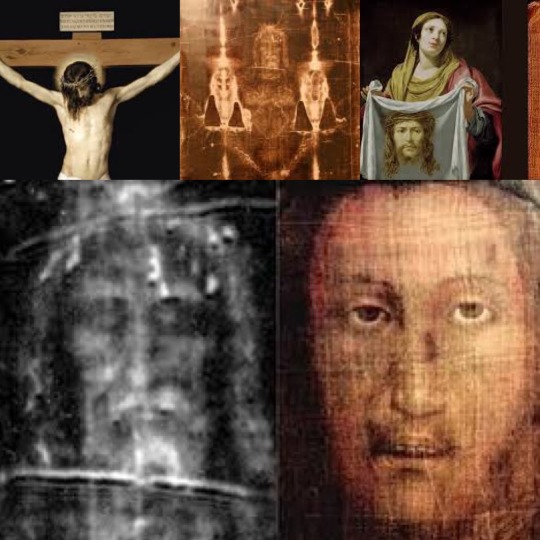#TitulusCrucis
Text

The Cloths of Christ: Holy Relics or Fakes?
Eli Kittim
Don’t be naive. Fakes, forgeries, and frauds are much more prevalent than you might think. Just as the “post-2002” Dead Sea Scrolls are fake, so are many Christian relics. For instance, take the “Titulus Crucis,” a piece of wood. Christian tradition claims that the relic contains a portion of the True Cross. Scientists, however, consider it to be a medieval forgery:
In 2002, the University of Arizona
conducted radiocarbon dating tests on the
artifact, and it was shown to have been
made between 980 and 1146 AD. The
carbon dating results were published in the
peer-reviewed journal Radiocarbon.
— Wiki
The same holds true for many other relics. Yet despite these setbacks, Christian archaeologists continue to make sensational claims that they have found the burning bush, the tomb of Jesus, the house of Peter, the Veil of Veronica (which btw is never mentioned in the canonical Gospels), and the like. They’re doing a great disservice to Christianity by promoting sensationalism and fake news. By advertizing hoaxes, fakes, and forgeries, they’re setting up Christianity to be mocked and ridiculed, and ultimately rejected. Once people realize that these relics are nothing more than fakes, frauds, and forgeries, they would want nothing to do with Christianity. In other words, the veracity of the Christian message is at stake. They’re setting people up to apostatize and deconstruct their faith. This is actually an attack on——not a support of——the Christian faith!
Pious Frauds
The Sudarium of Oviedo cloth——which is believed to be the post-mortem cloth that was wrapped around Jesus’ head, as mentioned in John 20:6–7——has been dated to around 700 AD by radiocarbon dating:
It’s a hoax!
The Manoppello Image of Jesus Christ’s face on a cloth is also a fake:
Most researchers state that, despite fringe
claims of divine origins, the face on the veil
at Manoppello clearly conforms in
appearance to the characteristics of an
artificially-made image and that stylistically
it is similar to images dating to the late
Middle Ages or early Renaissance.
— Wiki
The Shroud of Turin is also a 13th to 14th century hoax:
In 1988, radiocarbon dating by three
different laboratories established that the
shroud's linen material was produced
between the years 1260 and 1390 (to a
95% confidence level). Defenders of the
authenticity of the shroud have questioned
those results, usually on the basis that the
samples tested might have been
contaminated or taken from a medieval
repair to the original fabric. Such fringe
hypotheses have been refuted by carbon-
dating experts and others based on
evidence from the shroud itself, including
the medieval repair hypothesis, the bio-
contamination hypothesis and the carbon
monoxide hypothesis.
— Wiki
However, there was a recent research study on the Shroud of Turin (April 2022) by Dr. Liberato De Caro’s team which used the new “Wide-Angle X-ray Scattering” or WAXS method to determine the age of the shroud. They claim that they found a match with a piece of fabric from c. AD 55-74 from the siege of Masada in Israel. However, it is as yet unknown whether or not the findings are accurate. As far as I know, they have not been independently confirmed or multiply-attested by other laboratories. Dr. De Caro himself noted that his work was simply “evaluated and peer-reviewed by three other independent experts,” including the editor of the journal “Heritage,” which published his findings. But that doesn’t mean that the results were correct, multiply attested, or independently confirmed. It just means that a couple of editors thought that the experiment was worthy of publication. In fact, Dr. Liberato De Caro himself expressed the need for further research, especially “blind” tests to “avoid any possible bias in the data analysis by the authors of the research.” Bottom line, this new study has not yet conclusively refuted the 1988 radiocarbon dating findings by three different laboratories which established that the shroud is a medieval hoax.
As early as 1390, about 35 years after the
Shroud first emerged in France, Pierre
d'Arcis, the Catholic bishop in Troyes, wrote
to Pope Clement VII that the shroud was ‘a
clever sleight of hand’ by someone ‘falsely
declaring this was the actual shroud in
which Jesus was enfolded in the tomb to
attract the multitude so that money might
cunningly be wrung from them.’
— NBC News
The Roman Catholic Church considers the
Shroud to be an icon, not a holy relic.
— NBC News
Now, a new study using modern forensic
techniques suggests the bloodstains on the
shroud are completely unrealistic,
supporting arguments that it is a fake.
— Livescience
‘If you look at the bloodstains as a whole,
just as you would when working at a crime
scene, you realize they contradict each
other,’ Borrini said. ‘That points to the
artificial origin of these stains.’
— Livescience
Enough already with the hoaxes and the
fake news❗️
#relics#artifacts#burialcloth#HolyRelics#forgeries#frauds#TitulusCrucis#ελικιτίμ#fake news#medievalforgeries#radiocarbondating#Elikittim#VeilofVeronica#icons#Fakes#the little book of revelation#WAXS#SudariumofOviedo#bloodstains#Τομικροβιβλιοτηςαποκαλυψης#hoaxes#TheManoppelloImage#shroud of turin#catholic church#LiberatoDeCaro#Piousfrauds#forensictechniques#Christianrelics#religiousrelics#archaeology
1 note
·
View note